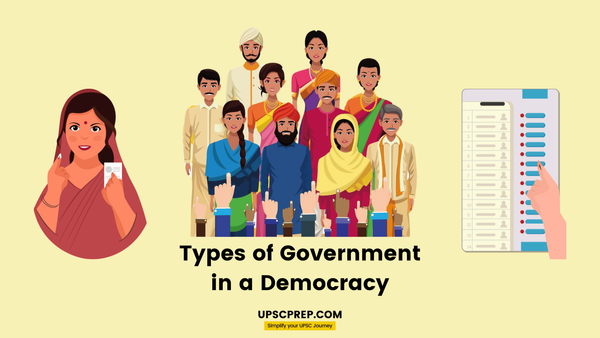Table of contents
1. Parliamentary Democracy
- Definition: A system where the executive branch derives its legitimacy from and is accountable to the legislature (parliament); the executive and legislative branches are interconnected.
- Key Features:
- The head of state is different from the head of government.
- The Prime Minister is the head of government and is usually the leader of the majority party in parliament.
- The government can be dissolved by a vote of no confidence.
- Examples: United Kingdom, India, Canada, Australia.
2. Presidential Democracy
- Definition: A system where the executive branch exists separately from the legislature and is not accountable to it; the president is both the head of state and the head of government.
- Key Features:
- The president is elected independently of the legislature.
- Fixed terms for the president and the legislature.
- Clear separation of powers between the executive, legislative, and judicial branches.
- Examples: United States, Brazil, Mexico.
3. Semi-Presidential Democracy
- Definition: A system that combines elements of both parliamentary and presidential systems; the president exists alongside a prime minister and a cabinet.
- Key Features:
- The president is elected by the people and has significant powers.
- The prime minister is appointed by the president but must have the confidence of the parliament.
- The executive powers are shared between the president and the prime minister.
- Examples: France, Russia, Portugal.
4. Direct Democracy
- Definition: A form of democracy where citizens have direct participation in decision-making processes.
- Key Features:
- Citizens vote on laws and policies directly rather than through elected representatives.
- Often used in conjunction with representative democracy for certain decisions.
- Examples: Switzerland (through referendums and initiatives), some U.S. states (through ballot propositions).

5. Representative Democracy
- Definition: A system where citizens elect representatives to make decisions on their behalf.
- Key Features:
- Regular, free, and fair elections.
- Elected representatives are accountable to the people.
- Examples: Most modern democracies, including India, the United States, and Germany.
6. Constitutional Democracy
- Definition: A system where the authority of the government is defined and limited by a constitution.
- Key Features:
- The constitution is the supreme law of the land.
- Protects the rights and freedoms of individuals.
- Examples: United States, India, South Africa.
7. Federal Democracy
- Definition: A system where power is divided between a central government and various regional governments.
- Key Features:
- Each level of government has its own responsibilities and powers.
- Examples: United States, India, Germany, Australia.
8. Unitary Democracy
- Definition: A system where a single central government holds the majority of the power, with any regional authorities being subordinate.
- Key Features:
- Centralized authority.
- Regional governments (if they exist) have powers delegated by the central government.
- Examples: United Kingdom, France, Japan.
9. Liberal Democracy
- Definition: A form of democracy that emphasizes the protection of individual rights and freedoms, often through a constitution.
- Key Features:
- Rule of law.
- Separation of powers.
- Protection of civil liberties.
- Examples: United States, Canada, European Union countries.
10. Social Democracy
- Definition: A political, social, and economic philosophy that supports political democracy alongside social ownership of the means of production, with an emphasis on social justice.
- Key Features:
- Welfare state provisions.
- Redistribution of wealth.
- Examples: Scandinavian countries like Sweden, Norway, Denmark.
11. Participatory Democracy
- Definition: A system that emphasizes broad participation of constituents in the direction and operation of political systems.
- Key Features:
- Encourages direct involvement of citizens in decision-making.
- Examples: Local governance models, community-based decision-making processes.
12. Deliberative Democracy
- Definition: A form of democracy in which deliberation is central to decision-making. It adopts elements of both direct and representative democracy.
- Key Features:
- Emphasizes the role of discussion and debate in making decisions.
- Examples: Citizens' assemblies, public consultations.
By understanding these various types of government in a democracy, you will be well-prepared for questions related to political systems and governance in the UPSC examination.
Previous Post